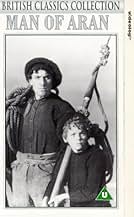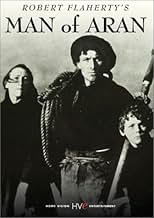IMDb RATING
7.1/10
2.4K
YOUR RATING
In this blend of documentary and fictional narrative from pioneering filmmaker Robert Flaherty, the everyday trials of life on Ireland's unforgiving Aran Islands are captured with attention ... Read allIn this blend of documentary and fictional narrative from pioneering filmmaker Robert Flaherty, the everyday trials of life on Ireland's unforgiving Aran Islands are captured with attention to naturalistic beauty and historical detail.In this blend of documentary and fictional narrative from pioneering filmmaker Robert Flaherty, the everyday trials of life on Ireland's unforgiving Aran Islands are captured with attention to naturalistic beauty and historical detail.
- Director
- Writer
- Stars
- Awards
- 3 wins total
- Director
- Writer
- All cast & crew
- Production, box office & more at IMDbPro
Featured reviews
As a child, I saw Man of Aran in my grandfather's living room. I didn;t understand why he seemed so moved by the Man of Aran. I recently learned that Colman King (the star) was my grandfather's first cousin. Delia King Donahue was my great grandmother, and her nephew was Colman King. As far as the film goes, it is what it is, the life and times of those trying to eek out a living under very adverse circumstances.
Does anyone know where I might obtain a poster(reproduction) of the movie? Yah, nostalgia)
Thanks, Sue
Does anyone know where I might obtain a poster(reproduction) of the movie? Yah, nostalgia)
Thanks, Sue
I rented this from Netflix recently. Visually, this picture is stunning. Some of the finest filming of the sea I've ever seen. The minimalist story really isn't much, just an attempt to provide some excuse for various actions in the film. This film is really not a documentary at all. One of the special features on the DVD is a short film called "Making the Myth" (or something like that), which is all about how the film was made, how Flaherty scripted various scenes, etc. As noted in the a previous review, the entire shark scene was something Flaherty pushed, recognizing that shark hunting sells. However, according to "Making the Myth," basking shark hunting had gone out over 50 years earlier. Apparently Flaherty also thought that, if he got people hunting the sharks for his move, they might start it up again as a local industry. We found a good portion of the dialogue almost unintelligible. Especially at the start, we thought they we speaking Gaelic! Still, the dialogue is really unnecessary. Flaherty uses old fashioned dialogue cards, like in a silent film, to explain what's coming up. Overall, this was a very interesting film to watch. Since it's just over an hour long, it's a good one to see when you have some time but don't want to commit to any "Major Movie Event!"
A silent movie with sounds added later, waves crashing and wind blowing and gulls calling and windy orchestral music based on Irish songs and people talking in heavy accents. Intertitles as well. There is no plot to speak of, just the rugged life on the Aran Isles, men going out to sea in small boats, women watching from the shore, a young boy eager to join the men, a shark hunt, big seas, and the men returning safely, but just barely. The photography is spectacular, giving a good sense of the near-barrenness of the islands and the old traditional life, not to mention providing amazing and frightening shots of huge waves thundering against cliffs and cascading back down in waterfalls all along the rim. All the men seem to wear the same outfit, work pants and a black wool sweater and a sort of tam with a big top-knot, and the almost too-cute boy wears the same. The dialogue must have been recorded separately and edited in: there's often none of the background noise we'd expect on location, and the lines have that tone of amateur improvisation. It might have been better to leave it as a silent movieas brilliant as Flaherty was, he took longer to make the transition to sound than anybody. Another thing. I was wondering about the extent to which Flaherty orchestrated the doings of the Aran people to fit his story (and his conception of the primitive life). Notwithstanding these grumblings, I'd still have to rate this very high, largely because of the photography, including the many low-angle shots of the boy and his mother walking along the cliffs with the sky soaring above them, the ocean shots, the intercutting for continuity, and the loving attention to landscape and human detail.
If you were to ask passers-by on the street if they'd be interested in seeing a 1934 documentary about the harsh day-to-day existence of a tiny community living on a remote island off the coast of Ireland -- well, you'd be standing there all day before you could find someone who'd say, "sure!". Which is really a disappointment because they don't know what they're missing!
Think of every poem you've read about the sea and man's relation to it and you might get a clue as to the depths of feeling that this film has. It's like Hemingway, Pablo Neruda and W.B. Yeats all rolled into one. It's extremely simplistic, just shots of how a small family fishes, hauls seaweed for fertilizer (there is no soil on the island) and dodges waves so high that its foam sprays above the cliff-tops. Not to mention an incredible sequence where five fishermen try to catch and kill a shark that is a good deal larger than their boat!
What's most exhilarating about this film is that while you're watching it, you can't help but think that these people are crazy to choose to live in such a desolate and difficult place, but then you try to imagine them elsewhere and you know that they are as much a part of that environment as the stubborn sea-worn cliffs are. After even thirty minutes of the film, the roar of the ocean and the cries of the gulls fill your head to such an extreme that you know that such people could live no where else. This film is reminiscent of Roberto Rossellini's film, "Stromboli" about the inhabitants of a small village on a volcanic island. There are a few brief pockets of sentimentality due to the score, but the filmmakers thankfully left out the music during all of the film's most important scenes. Overall what you have is an incredible cinematic experience that makes you think and imagine what it would be like to live a life where every day is a struggle with the elements of nature and a fight for survival, yet filled with the deepest awe and respect for nature and for living.
Think of every poem you've read about the sea and man's relation to it and you might get a clue as to the depths of feeling that this film has. It's like Hemingway, Pablo Neruda and W.B. Yeats all rolled into one. It's extremely simplistic, just shots of how a small family fishes, hauls seaweed for fertilizer (there is no soil on the island) and dodges waves so high that its foam sprays above the cliff-tops. Not to mention an incredible sequence where five fishermen try to catch and kill a shark that is a good deal larger than their boat!
What's most exhilarating about this film is that while you're watching it, you can't help but think that these people are crazy to choose to live in such a desolate and difficult place, but then you try to imagine them elsewhere and you know that they are as much a part of that environment as the stubborn sea-worn cliffs are. After even thirty minutes of the film, the roar of the ocean and the cries of the gulls fill your head to such an extreme that you know that such people could live no where else. This film is reminiscent of Roberto Rossellini's film, "Stromboli" about the inhabitants of a small village on a volcanic island. There are a few brief pockets of sentimentality due to the score, but the filmmakers thankfully left out the music during all of the film's most important scenes. Overall what you have is an incredible cinematic experience that makes you think and imagine what it would be like to live a life where every day is a struggle with the elements of nature and a fight for survival, yet filled with the deepest awe and respect for nature and for living.
I really enjoyed this film. It is best to ignore any questions about the plot and whether it is a movie or a documentary and just sit back and be transported back in time. The island is a beautiful, yet harsh and isolated place and the people are a product of that environment. I just saw the film after returning from a trip to Ireland, where we spent several enchanting days on the island, hiking in the rain. The locals told me about the movie, I had only a vague knowledge before then.
What has really sold me on the movie was the DVD edition we viewed it on. There is a wealth of details about the movie, the director, the island, and much more now available. Fans wedded to todays ultra-slick color and CGI productions might be disappointed, but for the serious movie fan this is a gem!
What has really sold me on the movie was the DVD edition we viewed it on. There is a wealth of details about the movie, the director, the island, and much more now available. Fans wedded to todays ultra-slick color and CGI productions might be disappointed, but for the serious movie fan this is a gem!
Did you know
- TriviaThe islanders hunt a basking shark for its oil, but they hadn't done so in generations. The filmmakers had to bring an Inuit hunter to show them how to do it as their ancestors might have.
- Alternate versionsThere is an Italian edition of this film on DVD, distributed by DNA srl, "L'UOMO DI ARAN (1934), NANUK L'ESCHIMESE (1922), OMBRE BIANCHE NEI MARI DEL SUD (1928)" (3 Films on a single DVD), re-edited with the contribution of film historian Riccardo Cusin. This version is also available for streaming on some platforms.
- ConnectionsEdited into Spisok korabley (2008)
Details
- Runtime1 hour 16 minutes
- Color
- Sound mix
- Aspect ratio
- 1.37 : 1
Contribute to this page
Suggest an edit or add missing content

Top Gap
By what name was Aran, l'île des tempêtes (1934) officially released in India in English?
Answer





















